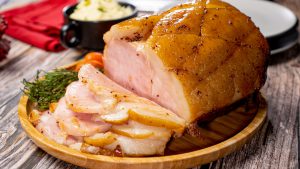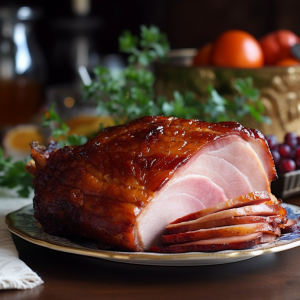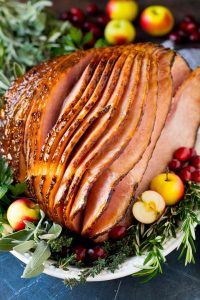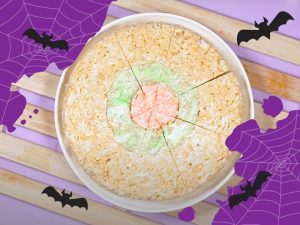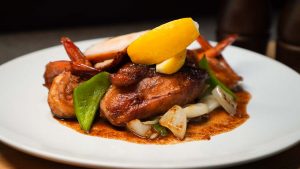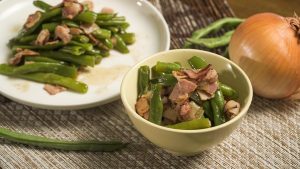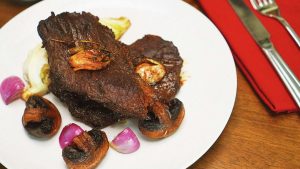Experience the rich, aromatic flavors of this rosemary balsamic glazed ham recipe. A perfect centerpiece for your holiday table, this ham is glazed with a sweet and tangy balsamic vinegar, brown sugar, and Dijon mustard mixture, then infused with rosemary for a delightful herbal accent. Savory, sweet, and subtly spiced, it's an easy yet impressive dish that's sure to dazzle your guests.
While most ingredients for this recipe are quite common, you might need to pay special attention to the Dijon mustard and balsamic vinegar. Dijon mustard, originating from Dijon, a city in eastern France, is smoother and less vinegary than yellow mustard. It is commonly used in gourmet recipes for its sophisticated, tangy flavor. Balsamic vinegar, traditionally made in Modena, Italy, is a dark, concentrated, and intensely flavored vinegar made wholly or partially from grape must. For this recipe, choose a good quality balsamic vinegar for the best flavor.
Ingredients for Rosemary Balsamic Glazed Ham
Ham: This is the main component of the recipe. An 8 lbs bone-in ham is preferred for its flavor and texture.
Brown sugar: This is used to sweeten the glaze and gives the ham a nice, caramelized crust.
Balsamic vinegar: It adds a touch of acidity and complex flavor to the glaze, balancing the sweetness of the brown sugar.
Dijon mustard: It adds a tangy, spicy kick to the glaze, complementing the flavors from the vinegar and sugar.
Rosemary: This herb infuses the ham with its unique, aromatic flavor, enhancing the overall taste of the dish.
Black pepper: It adds a bit of heat and enhances the flavors of the other ingredients.
White wine: This is used to keep the ham moist during cooking and also adds a subtle fruity flavor.
One reader, Giulia Fiedler says:





This rosemary balsamic glazed ham recipe is a game-changer! The flavors are a perfect blend of sweet and savory, and the aroma while it's cooking is simply mouthwatering. The glaze caramelizes beautifully, giving the ham a gorgeous finish. It's a must-try for any special occasion!
Essential Techniques for Making Rosemary Balsamic Glazed Ham
How to score the ham: Make diagonal cuts across the surface of the ham, then repeat in the opposite direction to create a diamond pattern. This will allow the glaze to penetrate the ham and infuse it with flavor.
How to baste the ham: Use a basting brush to apply the leftover glaze to the ham periodically while it bakes. This will help to keep the ham moist and flavorful.
How to carve the ham: After allowing the ham to rest, carve it by slicing against the grain to ensure tender, juicy slices.
How To Make Rosemary Balsamic Glazed Ham
This delectable balsamic glazed ham recipe is so juicy with crispy edges from the brown sugar glazed. It is perfect for holidays or any gatherings.
Serves:
Ingredients
- 8lbsbone in hamcooked
- ⅓cupbrown sugar
- 3tbspbalsamic vinegar
- 3tbspdijon mustard
- 1tbsprosemarycrushed
- 1tspblack pepper((or to taste))
- 1cupwhite wineor champagne ((optional))
Instructions
-
Soak the ham in cold water in the fridge for 4 to 6 hours before cooking and discard water.
-
Score diagonal lines across ham each way creating a checkerboard (this allows the glaze to get into the ham)
-
Mix together brown sugar, balsamic vinegar, dijon, pepper, and rosemary and brush over ham.
-
Put ham in a dish just big enough to hold the ham.
-
Add wine/champagne to the bottom of the pan.
-
Bake uncovered according to package directions basting with leftover glaze occasionally.
-
Once done, remove ham from oven and cover. Allow resting for 15 minutes.
-
Slice and serve.
Nutrition
- Calories: 530.93kcal
- Fat: 26.15g
- Saturated Fat: 8.89g
- Trans Fat: 0.00g
- Monounsaturated Fat: 13.25g
- Polyunsaturated Fat: 2.42g
- Carbohydrates: 17.13g
- Fiber: 4.17g
- Sugar: 4.73g
- Protein: 50.41g
- Cholesterol: 172.37mg
- Sodium: 3502.44mg
- Calcium: 82.73mg
- Potassium: 901.70mg
- Iron: 3.29mg
- Vitamin A: 0.47µg
- Vitamin C: 12.14mg
Crucial Technique Tip for Perfecting Rosemary Balsamic Glazed Ham
When scoring the ham, ensure your knife is sharp and you're making cuts about 1/4 inch deep. This will allow the rosemary balsamic glaze to penetrate into the meat, enhancing the flavor throughout. Be careful not to cut too deep, as this could cause the ham to dry out during baking.
Time-Saving Tips for Making Rosemary Balsamic Glazed Ham
Prep ahead: Prepare the glaze and score the ham the night before. This will save time on the day of cooking. Use a roasting bag: Cooking the ham in a roasting bag will help retain moisture and flavor, while also reducing the cleanup time. Invest in a good knife: A sharp, quality knife will make slicing the ham a breeze, saving time and effort in the kitchen. Set up a basting station: Prepare all the basting ingredients in a small bowl beforehand to make the basting process quick and efficient. Multi-task: While the ham is baking, use that time to prepare side dishes or set the table to make the most of your time in the kitchen.
Substitute Ingredients For Rosemary Balsamic Glazed Ham Recipe
brown sugar - Substitute with honey: Honey can add a similar sweetness and caramelization to the ham, while also providing a unique flavor profile.
balsamic vinegar - Substitute with apple cider vinegar: Apple cider vinegar can provide a tangy and slightly sweet flavor similar to balsamic vinegar, complementing the ham well.
dijon mustard - Substitute with whole grain mustard: Whole grain mustard can offer a similar tanginess and texture, adding depth of flavor to the glaze.
rosemary - Substitute with thyme: Thyme can provide a similar earthy and aromatic flavor, enhancing the overall taste of the glazed ham.
white wine - Substitute with apple juice: Apple juice can add a touch of sweetness and acidity, similar to white wine, while also helping to tenderize the ham.
Presentation Tips for a Stunning Rosemary Balsamic Glazed Ham
Elevate the plating: When presenting the ham, ensure that the plating is elegant and refined. Use edible flowers and fresh herbs to garnish the dish, adding a pop of color and a touch of sophistication.
Incorporate texture: Add a contrast in texture by serving the ham with a side of crispy roasted potatoes or caramelized root vegetables. This will provide a delightful crunch and depth to the dish.
Create a stunning glaze: Ensure the glaze on the ham is glossy and evenly distributed, creating a visually appealing shine that reflects the light. This will make the dish look irresistible and appetizing.
Use elegant serving platters: Present the ham on a beautiful serving platter or wooden board to add a touch of rustic charm to the overall presentation.
Attention to detail: Pay attention to the placement of each slice of ham on the plate, ensuring that it is arranged neatly and thoughtfully. This level of precision will demonstrate your dedication to the craft.
Essential Tools for Making Rosemary Balsamic Glazed Ham
- Oven: A kitchen appliance used for baking and roasting food.
- Basting brush: A brush used to apply sauces, marinades, or glazes to food during cooking.
- Baking dish: A dish used for baking food in the oven.
- Knife: A tool used for cutting and slicing ingredients.
- Cutting board: A flat surface used for cutting and preparing food.
- Measuring cups and spoons: Used for accurately measuring ingredients for recipes.
- Roasting pan: A deep, wide pan used for roasting meats and vegetables in the oven.
- Mixing bowl: A bowl used for mixing ingredients together.
- Baking sheet: A flat, rectangular metal pan used for baking and roasting.
- Saucepan: A deep cooking pan with a handle used for making sauces and heating liquids.
Storing and Freezing Rosemary Balsamic Glazed Ham: A Guide
Here are the storing and freezing guidelines for rosemary balsamic glazed ham:
- Let the ham cool completely before storing or freezing. This usually takes about 30 minutes to 1 hour.
- Slice the ham into desired portions for easier storage and reheating.
- For storing in the refrigerator:
- Place the sliced ham in an airtight container or wrap tightly with plastic wrap or aluminum foil.
- Store in the refrigerator for up to 5 days.
- For freezing:
- Wrap the sliced ham tightly with plastic wrap or aluminum foil, making sure to remove as much air as possible.
- Place the wrapped ham in a freezer-safe container or freezer bag.
- Label the container or bag with the date and contents.
- Freeze for up to 2 months for best quality.
- To reheat:
- For refrigerated ham, place the desired portion on a microwave-safe plate and heat in the microwave for 1-2 minutes, or until heated through.
- For frozen ham, thaw in the refrigerator overnight before reheating. Place the desired portion on a microwave-safe plate and heat in the microwave for 2-3 minutes, or until heated through.
- Alternatively, you can reheat the ham in a preheated oven at 325°F (165°C) for 10-15 minutes, or until heated through.
How To Reheat Leftover Rosemary Balsamic Glazed Ham
Preheat your oven to 325°F (165°C). Place the leftover ham in a baking dish and cover it with aluminum foil. Bake for about 10 minutes per pound, or until the internal temperature reaches 135°F (57°C). This method helps to retain the moisture and flavor of the ham, while also allowing the glaze to caramelize slightly.
Another option is to use a slow cooker. Place the leftover ham in the slow cooker and add about 1/2 cup of chicken broth or water to the bottom of the pot. Cover and cook on low for 2-3 hours, or until the ham is heated through. This method is great for keeping the ham moist and tender.
For a quicker option, you can use a microwave. Place the leftover ham in a microwave-safe dish and add a tablespoon of water or chicken broth. Cover the dish with a damp paper towel and microwave on high for 1-2 minutes per slice, or until the ham is heated through. Be careful not to overheat the ham, as it can dry out quickly in the microwave.
If you want to add some extra flavor to your leftover ham, try slicing it thinly and sautéing it in a pan with a little bit of butter or olive oil. You can also add some garlic, onions, or herbs to the pan for extra flavor. This method is great for making ham sandwiches or adding ham to omelets or quiches.
Finally, if you have a lot of leftover ham, you can freeze it for later use. Wrap the ham tightly in plastic wrap or aluminum foil and place it in a freezer-safe container. When you're ready to use it, thaw the ham in the refrigerator overnight and then reheat it using one of the methods above.
Interesting Trivia About Rosemary Balsamic Glazed Ham
Balsamic vinegar is a versatile ingredient that adds a unique flavor to dishes. It is often used in glazes, dressings, and marinades, and its sweet and tangy taste pairs well with a variety of foods.
Is Making Rosemary Balsamic Glazed Ham at Home Cost-Effective?
The cost-effectiveness of this rosemary balsamic glazed ham recipe largely depends on the price of the ham and balsamic vinegar. While ham can be relatively affordable, balsamic vinegar might be a pricier ingredient. However, considering the serving size and the fact that ham can often be used for multiple meals, it can be a reasonable investment. The rich flavors and versatility of the dish make it a worthwhile addition to a household menu. On a scale of 1-10, I would rate this recipe an 8 for its taste and flexibility. The approximate cost for a household of 4 people would be around $25-$30.
Is Rosemary Balsamic Glazed Ham Healthy or Unhealthy?
The rosemary balsamic glazed ham recipe is a delicious and flavorful dish, but it may not be the healthiest option due to its high sodium and sugar content. Ham is inherently high in sodium, and this recipe adds even more with the glaze ingredients like brown sugar and balsamic vinegar. The white wine used in the cooking process also contributes to the overall calorie count.
However, there are some positive aspects to this recipe. The use of rosemary, a fragrant herb, adds a unique flavor profile and potential health benefits. Rosemary is known for its anti-inflammatory and antioxidant properties. The dijon mustard in the glaze also provides a tangy kick without adding significant calories or fat.
To make this recipe healthier, consider the following suggestions:
- Opt for a lower sodium ham or reduce the portion size to control sodium intake
- Replace the brown sugar with a natural sweetener like honey or maple syrup to minimize processed sugar
- Increase the amount of rosemary and other herbs to enhance flavor without relying on salt or sugar
- Serve the ham with a variety of nutrient-dense side dishes, such as roasted vegetables or a fresh salad, to balance out the meal
- Use a leaner cut of ham, such as a ham steak or Canadian bacon, to reduce overall fat content
By making these adjustments, you can still enjoy the delightful taste of rosemary balsamic glazed ham while promoting a more balanced and nutritious meal.
Editor's Take on This Delightful Rosemary Balsamic Glazed Ham Recipe
This rosemary balsamic glazed ham recipe is a delightful combination of sweet and savory flavors. The brown sugar and balsamic vinegar create a rich glaze, while the dijon mustard adds a hint of tanginess. The aromatic rosemary and black pepper add depth to the dish, and the white wine brings a touch of brightness. The scoring of the ham allows the flavors to penetrate, resulting in a succulent and flavorful ham. This recipe is sure to impress your guests and elevate any special occasion meal.
Enhance Your Rosemary Balsamic Glazed Ham Recipe with These Unique Side Dishes:
Delicious Alternatives to Rosemary Balsamic Glazed Ham
Appetizers and Desserts That Complement Rosemary Balsamic Glazed Ham
Why trust this Rosemary Balsamic Glazed Ham Recipe:
This recipe is a guaranteed crowd-pleaser, featuring a succulent ham glazed with a delightful combination of balsamic vinegar, brown sugar, and dijon mustard. The aromatic rosemary adds a fragrant touch, while the white wine infuses the ham with a rich depth of flavor. The scoring of the ham ensures that the glaze permeates every bite, resulting in a tender and flavorful dish. Trust the combination of these high-quality ingredients to elevate your dining experience and impress your guests.
Was this page helpful?
Have your own special recipe to share? Submit Your Recipe Today!



